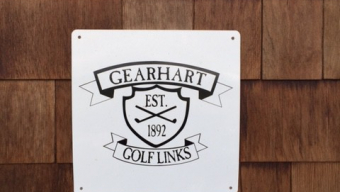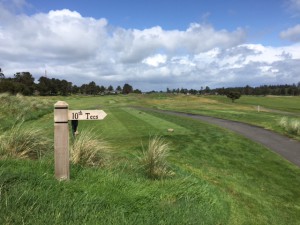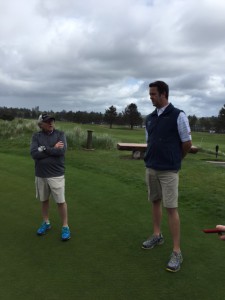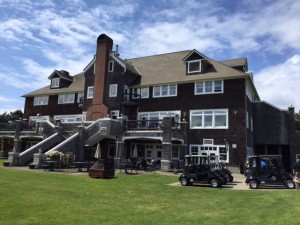GEARHART, Or. – Some bunch of golf experts we are.
Northwest golf writers recently got together to play a coastal course near Seaside called Gearhart Golf Links. Most of the group had never played the course and at least half had never heard of it, including me.
You wonder why. Gearhart is merely 124 years old. It’s the oldest continually used golf course west of the Mississippi. It was originally laid out for play in 1892, two years even before the United States Golf Association was established and just 33 years after Oregon became a state. Lewis & Clark’s campfire might have been still warm.
How could we have missed this one? How could we had not played it? It’s a really interesting, fun tract that has been revised and revitalized by owner Tim Boyle.
“Our family grew up playing here. It’s an institution that needed to be saved,” said Boyle, who also is the CEO and President of Columbia Sportswear.
Boyle is quite a rich man and he used his wealth six years ago to make a statement. This was his public-service purchase. Generations have of golfers in this resort region grew up playing this ancient layout. It’s a special, beloved and vital part of this community and Boyle wanted to preserve and restore its history.
It was originally forged by a handful of homesick Scotsmen who were used to the sandy circuits of their homeland. Led by Robert Livingston, a prominent Portland resident, a group put together a four-hole layout in the late 1880s. Livingston actually built a home on the property.
Marshall Kinney was credited with designing the original circuit but such famous architects as Chandler Egan (Eugene CC, West Seattle GC, Pebble Beach GC redesign) and Bill Robinson (more than 300 designed or renovated) and had a hand to retouching Gearhart.
Gearhart could not have been more isolated in those early days. There was nothing there except a rugged shoreline, sand dunes and tree groves. You could only reach the property by boat from Astoria to the north. The coastal mountain range prevented Portland golfers from getting here until railways connected the region to Portland, Seattle and Spokane in 1907.
If you did manage to get here, it was about the only place you could hit a ball around for years.
There are a handful of quality courses around the area today, none quite like this one.
It’s a quasi-links style course. It’s all grass-covered with a few fescue pockets and pot bunkers. There are no rolling sand dunes or vast waste areas or even any holes adjacent to the water. The Pacific is just over a hill, offering a measure of needed wind protection.
It’s also not a pure parklands course. Two years ago, Boyle added 11 new tees, lengthening the layout, and took out 400 trees to bring back the links affect, opening up the fairways and expanding the vistas to bring in the coastal mountains.
“The course revealed itself,” said Boyle, who bought out all his partners five years ago.
It’s now an tight yet open, sand-based, firm-and-fast course. It’s lined with some houses, only on the perimeter and only within an errant reach on a couple holes. Much like the old Scottish courses, it’s quite tight to the point where you might find yourself hitting into the wrong green or teeing off in a misguided direction.
The front nine is to your left (north) as you exit the clubhouse and the full back nine is in front of you and to the right (south). The recommendation is to play it twice because there’s a lot of local knowledge to be absorbed, especially finding the line for your tee shots.
With the added tees (using the full measure of the footprint), it is 6,501 from the tips at a par-72.
The three par-5s are the most compelling and perhaps infuriating. The property is roughly rectangular and the par-5, 487-yard eighth hole essentially comprises the entire width – east to west – of the course. It’s takes three long, quality shots to reach the green.
The par-5, 544-yard 13th is straight-forward along the back perimeter of the course with the wind generally behind you. Take advantage here because the par-5, 640-yard 18th gives you nothing but heartache if you have a good score at that point.
The hole is so long the back tee is in someone’s front yard, using every inch of distance available. The length is massive and the wind makes it par impossible. It’s against you the entire way, the entire year. And it’s strong. After all of us in our group hit two decent shots, we walked to our balls we passed over the 248-yard distance marker. Yet our third shots were still well over 200 yards to go. If you can reach the green – up a hill at a slight dogleg – in four you’ve done something. It may be the hardest hole in the Northwest.
Gearhart has the earmarks of a links layouts like the British and Irish Isles. In fact, about 25 members of the Gearhart’s sister course at Carne Golf Links in Ireland, annually make the trek over to Gearhart to play the course. And a local Gearhart member group annually visits Carne.
What adds to the links atmosphere is the magnificent old-new clubhouse/hotel/restaurant. It was built in 2001, the fourth one on that spot. Two burned down and one was torn down after a 50-year run. This latest one is made to look like that venerable one, with barn planks throughout to give it a turn-of-a-century motif.
The four-story structure features the Pot Bunker bar at ground level. Good beer, good pizza. For a more fine-dining experience, the Sandtrap Restaurant is on the second level. This draws in plenty of locals, golfers and non-golfers alike. Both are served by the popular McMenamins chain. Boyle went to school with Mike McMenamin and enticed him to expand to the course six years ago.
The area has plenty of stay-and-play packages with the added benefits of the beach activities, great surfing, clamming and fishing.
It’s an Oregon institution, one every Northwest golfer should know. And every Northwest golf writer.
























